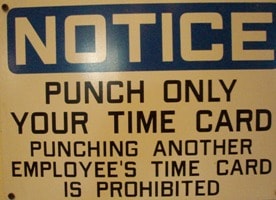If you know of additional companies that aid with human
rights issues, please let us know.
View more about Human Rights Associations & Organizations
 Most persons in textile, apparel and furnishings occupations
work a standard 5-day, 35- to 40-hour week. Evenings and weekend work is
common for shoe and leather workers, laundry and drycleaning workers, and
tailors, dressmakers, sewers employed in retail stores. In manufacturing,
some employers add second shifts to justify the expense of new machinery.
Many textile and fiber mills often use rotating schedules of shifts so that
employees do not continuously work nights or days. But these rotating shifts
sometimes cause workers to have sleep disorders and stress-related problems.
Most persons in textile, apparel and furnishings occupations
work a standard 5-day, 35- to 40-hour week. Evenings and weekend work is
common for shoe and leather workers, laundry and drycleaning workers, and
tailors, dressmakers, sewers employed in retail stores. In manufacturing,
some employers add second shifts to justify the expense of new machinery.
Many textile and fiber mills often use rotating schedules of shifts so that
employees do not continuously work nights or days. But these rotating shifts
sometimes cause workers to have sleep disorders and stress-related problems.
While much of the work in apparel manufacturing still is based on a piecework system that allows for little interpersonal contact, some apparel firms are placing more emphasis on teamwork and cooperation. Under this new system, individuals work closely with one another and each team or module often governs itself, increasing the overall responsibility of each operator.
Working conditions vary by establishment and by occupation. In manufacturing, machinery in textile mills often is noisy, as are areas in which sewing and pressing are performed in apparel factories; patternmaking and spreading areas tend to be much quieter. Many older factories are cluttered, hot, and poorly lit and ventilated, but more-modern facilities usually have more workspace and are well-lit and ventilated. Textile machinery operators use protective glasses and masks that cover their noses and mouths to protect against airborne materials. Many machines operate at high speeds, and textile machinery workers must be careful not to wear clothing or jewelry that could get caught in moving parts. In addition, extruding and forming machine operators wear protective shoes and clothing when working with certain chemical compounds.
Work in apparel production can be physically demanding. Some workers sit for long periods, and others spend many hours on their feet, leaning over tables and operating machinery. Operators must be attentive while running equipment such as sewing machines, pressers, and automated cutters. A few workers wear protective devices such as gloves. In some instances, new machinery and production techniques have decreased the physical demands upon workers. For example, newer pressing machines now are operated by foot pedals or computer controls, and do not require much strength to operate.
Laundries and drycleaning establishments often are hot and noisy; but those in retail stores tend to be less noisy and more comfortable. Areas in which shoe and leather workers make or repair shoes and other leather items can be noisy and odors from leather dyes and stains often are present. Workers need to pay close attention when working with machines to avoid punctures, lacerations, and abrasions.
Bureau of Labor Statistics, U.S. Department of Labor, Occupational Outlook Handbook, 2002-03 Edition, Textile, Apparel, and Furnishings Occupations, on the Internet at http://www.bls.gov/oco/ocos233.htm (visited November 16, 2003).